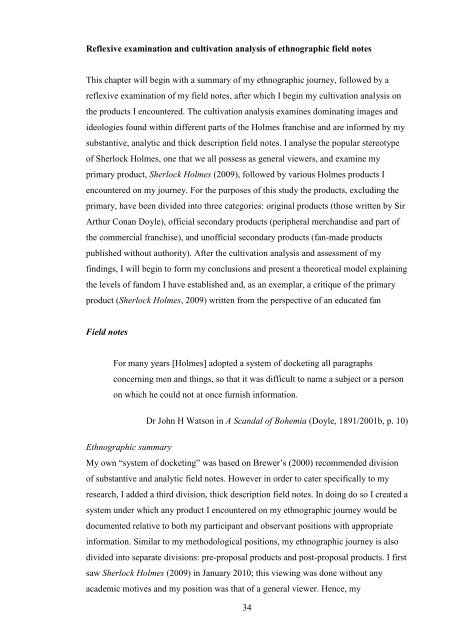The Case Study of Sherlock Holmes (2009) - Scholarly Commons ...
The Case Study of Sherlock Holmes (2009) - Scholarly Commons ...
The Case Study of Sherlock Holmes (2009) - Scholarly Commons ...
You also want an ePaper? Increase the reach of your titles
YUMPU automatically turns print PDFs into web optimized ePapers that Google loves.
Reflexive examination and cultivation analysis <strong>of</strong> ethnographic field notes<br />
This chapter will begin with a summary <strong>of</strong> my ethnographic journey, followed by a<br />
reflexive examination <strong>of</strong> my field notes, after which I begin my cultivation analysis on<br />
the products I encountered. <strong>The</strong> cultivation analysis examines dominating images and<br />
ideologies found within different parts <strong>of</strong> the <strong>Holmes</strong> franchise and are informed by my<br />
substantive, analytic and thick description field notes. I analyse the popular stereotype<br />
<strong>of</strong> <strong>Sherlock</strong> <strong>Holmes</strong>, one that we all possess as general viewers, and examine my<br />
primary product, <strong>Sherlock</strong> <strong>Holmes</strong> (<strong>2009</strong>), followed by various <strong>Holmes</strong> products I<br />
encountered on my journey. For the purposes <strong>of</strong> this study the products, excluding the<br />
primary, have been divided into three categories: original products (those written by Sir<br />
Arthur Conan Doyle), <strong>of</strong>ficial secondary products (peripheral merchandise and part <strong>of</strong><br />
the commercial franchise), and un<strong>of</strong>ficial secondary products (fan-made products<br />
published without authority). After the cultivation analysis and assessment <strong>of</strong> my<br />
findings, I will begin to form my conclusions and present a theoretical model explaining<br />
the levels <strong>of</strong> fandom I have established and, as an exemplar, a critique <strong>of</strong> the primary<br />
product (<strong>Sherlock</strong> <strong>Holmes</strong>, <strong>2009</strong>) written from the perspective <strong>of</strong> an educated fan<br />
Field notes<br />
For many years [<strong>Holmes</strong>] adopted a system <strong>of</strong> docketing all paragraphs<br />
concerning men and things, so that it was difficult to name a subject or a person<br />
on which he could not at once furnish information.<br />
Ethnographic summary<br />
Dr John H Watson in A Scandal <strong>of</strong> Bohemia (Doyle, 1891/2001b, p. 10)<br />
My own “system <strong>of</strong> docketing” was based on Brewer‟s (2000) recommended division<br />
<strong>of</strong> substantive and analytic field notes. However in order to cater specifically to my<br />
research, I added a third division, thick description field notes. In doing do so I created a<br />
system under which any product I encountered on my ethnographic journey would be<br />
documented relative to both my participant and observant positions with appropriate<br />
information. Similar to my methodological positions, my ethnographic journey is also<br />
divided into separate divisions: pre-proposal products and post-proposal products. I first<br />
saw <strong>Sherlock</strong> <strong>Holmes</strong> (<strong>2009</strong>) in January 2010; this viewing was done without any<br />
academic motives and my position was that <strong>of</strong> a general viewer. Hence, my<br />
34

















